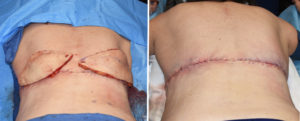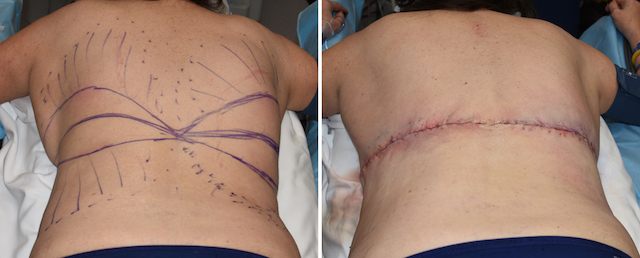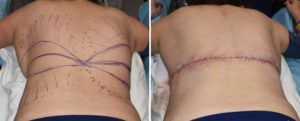Background: The back is an area that is prone to develop thickness due to fat accumulation and skin rolls. This seems to be more common in women, in certain body types and with aging and weight gain. These back rolls typically develop as more obliquely oriented sagging tissues excesses. The standard treatment for back ‘lipodystrophy’ is liposuction. Due to the thicker skin on the back, removal of fat by liposuction is likely to develop some good skin retraction. This may reduce or completely eliminate back skin rolls in some patients.
But back rolls in some patients do not respond well to just liposuction alone. They become reduced but the excess skin problem/roll does not go away. For women back rolls become magnified due to the wearing of a bra, which makes them stick out beyond it, and they become visible through form fitting clothes.
The definitive treatment for back rolls is excision which removes skin and fat. Because of the creation of a scar it takes a motivated patient to be willing to accept that tradeoff. If the back roll is excised along the line in which it lies the resultant back scar would be in an oblique orientation which would be quite visible. Removing it in a horizontal orientation seemingly works away from the line of the skin roll but it has the opportunity to place the horizontal scar in more favorable clothing coverage.
Case Study: This middle aged female was bothered by thick skin rolls on her back. She wanted the most definitive treatment for them and was interested in the ‘braline backlift’ approach for them. Markings prior to surgery were a horizontally oriented ‘figure-of-eight’ form laid right across her braline from one side of the chest wall to the other side.


When doing the braline backlight it is important to not take a wide excision of tissue across the vertical spine area. The tissue over the spin is very adherent and besides creating difficulty with closure it it susceptible to postoperative wound dehiscence with bending over. This is why it should be left out of the excision zone. It will get puffy when the excised areas are closed. (dog ear effect) But this can be flattened with small cannula liposuction after closure.
Case Highlights:
1) Excess skin rolls on the back can be reduce by liposuction but not completely eliminated.
2) The braline backlift excises back rolls in a horizontal orientation across the middle of the back along the braline.
3) A braline backlift should either spare the midline of the back over the spine or minimize tissue removal there to prevent wound healing problems or the risk of hypertrophic scarring.
Dr. Barry Eppley
Indianapolis, Indiana





